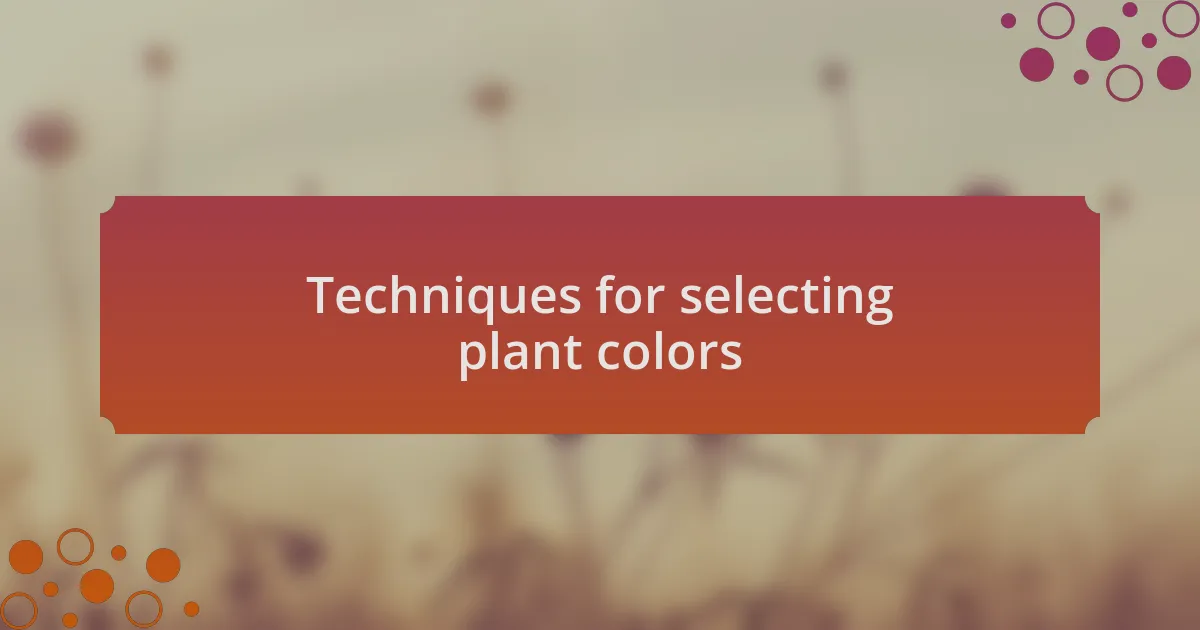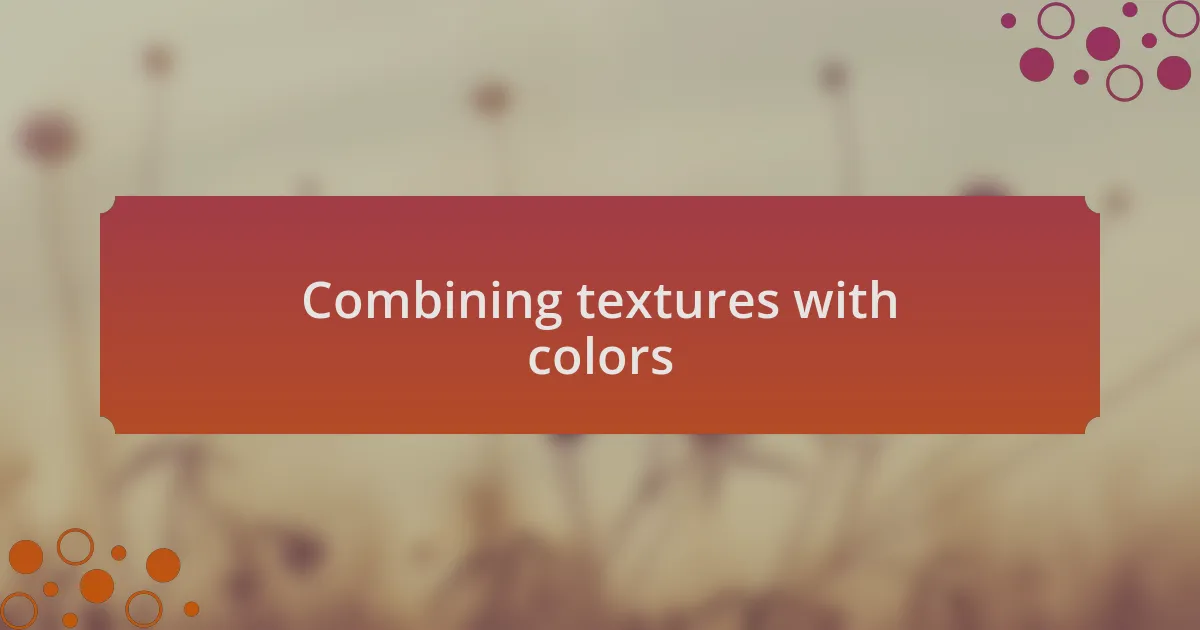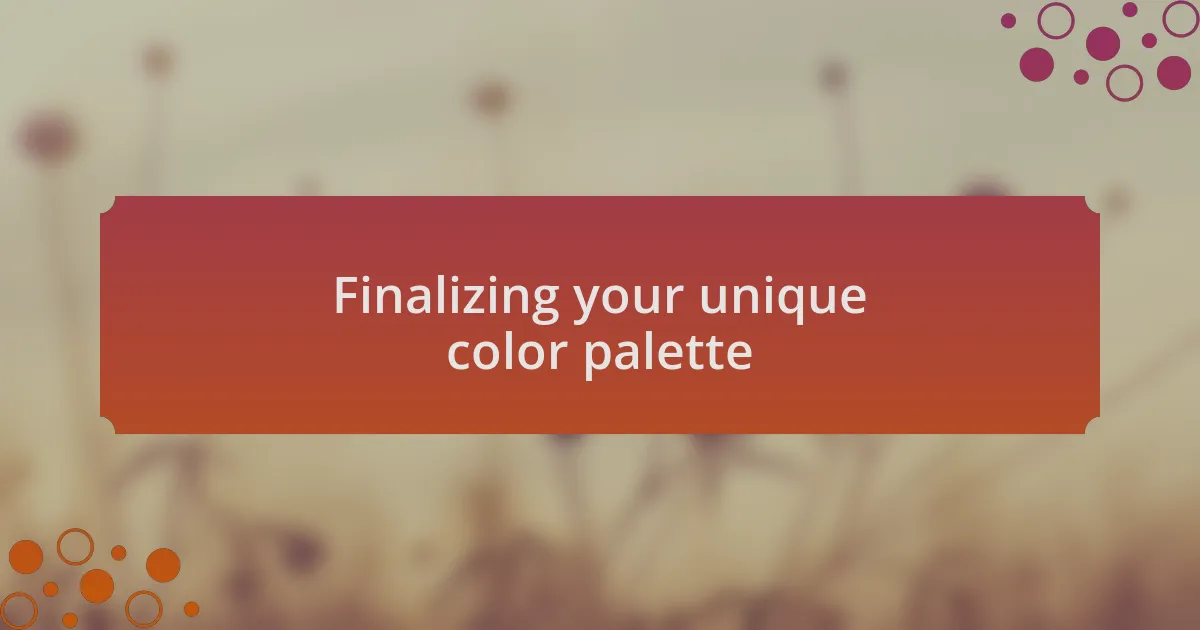Key takeaways:
- Color palettes greatly influence the mood and cohesion of a space, making choices about color essential in design.
- Personal preferences and emotional connections significantly shape individual color choices and can transform a space’s atmosphere.
- Combining textures with colors enhances the visual depth and engages the senses, creating a dynamic interior landscape.
- Finalizing a color palette involves reflecting on emotional impacts, seeking inspiration from admired spaces, and utilizing mood boards for visualization.

Understanding color palettes in design
Color palettes serve as the backbone of any design, significantly influencing the mood and perception of a space. I remember when I first experimented with color in my own home; choosing the right shades transformed the atmosphere entirely. Have you ever walked into a room that just felt “off” because of mismatched colors? That subtlety speaks volumes about the power of color.
In design, a well-constructed color palette helps create harmony and flow, making spaces feel cohesive rather than chaotic. I often find myself drawn to nature for inspiration – those moments in a lush garden where the interplay of greens and florals captivates me. Can you recall a time when a color caught your attention so much that it changed how you felt about a space? Those experiences can guide our choices in interior landscaping.
Ultimately, understanding color palettes goes beyond just aesthetics; it’s about emotional impact and personal expression. When I choose a palette, I reflect on what feelings I want to evoke—calming blues, energizing yellows, or perhaps grounded earth tones. What emotions do you want your space to convey? That’s the essence of creating a balanced color palette in design.

Techniques for selecting plant colors
When selecting plant colors, I often rely on the principles of complementary and analogous colors. For instance, the first time I paired deep purple flowers with vibrant yellow foliage, the vibrant contrast took my breath away. Have you experienced the joy of seeing colors work in perfect harmony, creating a visual delight that captures your attention immediately?
I also like to consider the seasonal changes in plant colors, as they can dramatically shift the mood of a space. One winter, I had a collection of evergreen plants that contrasted beautifully with the rich red berries of holly. That striking display reminded me that color is not just about what’s blooming now; it’s also about what transitions beautifully throughout the year. How do you envision the variations of color in your own space?
In trusting my instincts, I often reflect on the emotions that different colors evoke. For example, when I incorporated soothing greens in my home office, I noticed a significant boost in my productivity and mental clarity. Have you thought about how the colors around you affect your mood? It’s fascinating to realize that making intentional choices about plant colors can turn any area into a haven that inspires and rejuvenates.

Personal preferences in color choices
Personal preferences in color choices play a crucial role in how I design my own interior landscapes. For instance, I’ve always been drawn to earthy tones like terracotta and deep greens. A few years ago, I decorated my living space with these colors, and it wasn’t long before I felt a more grounded and comforting energy in the room. Have you ever experienced a color scheme that just felt like home?
I find that personal history often influences my color preferences. My grandmother had a garden filled with soft pastels, which sparked my love for shades like blush pink and lavender. Each time I incorporate these colors into my plant displays, it jogs sweet memories of her loving care and warm embraces. How do your past experiences shape the colors you’re drawn to in your own living spaces?
Engagement with color is not just about aesthetics; it’s an emotional journey. I remember vividly the time I introduced fiery reds and oranges into my workspace. Initially, I was hesitant, concerned that such vibrant hues might be too overpowering. To my surprise, these colors fostered a renewed sense of creativity and inspiration. Have you thought about how different colors can rejuvenate your creativity in unexpected ways?

Combining textures with colors
When I blend textures with colors in my interior landscaping projects, I aim for a harmonious balance that brings the space to life. For example, pairing a rich, deep green with a soft, matte finish on furniture creates a serene backdrop, while the combination of shiny ceramic pots with vibrant, glossy flowers adds an unexpected layer of interest. Have you noticed how the feel of materials can change your perception of color in a room?
One of my favorite experiments involved juxtaposing a rough, natural wood texture against smooth, pastel-colored ceramic planters. The contrast not only highlighted the colors beautifully but also added a tactile element that invited touch and interaction. Think about how texture can transform a simplistic color palette into something dynamic and engaging in your own home.
There was a time when I used a sleek, metal planter with a bold turquoise hue against a backdrop of soft linen drapes. The visual tension created a sense of sophistication, yet comfort, prompting guests to comment on the vibrancy of the space. It made me wonder if you’ve considered how combining varying textures can elevate your chosen colors to make a stronger statement in your interior landscape?

Finalizing your unique color palette
As I sit down to finalize my unique color palette, I always think about the emotional impact of each hue. For instance, I once selected a warm peach for a cozy reading nook and paired it with cool gray accents. The blend created an inviting environment that felt both calm and energizing, encouraging me to spend more time there. What colors evoke feelings for you, and how can you incorporate those into your own space?
When I finalize my palette, I often revisit the spaces I admire most. On one occasion, I took inspiration from a sunlit garden, allowing natural colors of earth and sky to guide my choices. By grounding my selections in nature, I achieved harmony and balance. Reflecting on what resonates with you personally can help clarify your final color decisions. Have you ever thought about how your favorite places can serve as a treasure trove of color inspiration?
I also believe it’s crucial to create a mood board during this finalization phase. For me, layering swatches and samples helps visualize how colors interact in the actual space. I remember celebrating the moment when my board started to resonate. It was like putting together pieces of a puzzle that finally made sense together. What if you experimented with this method to see how your selected colors actually play off one another before committing to your interior landscape?